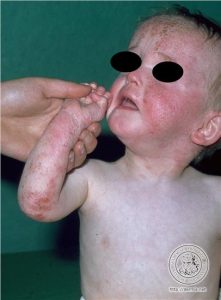SERVICES
- Allergy Screening
- Chemical Peels
- Dermapen
- Facial Skin Analysis
- FreshEyes
- Hyperhidrosis (Excessive Sweating)
- Hair Loss Treatment
- Laser Clinic
- Liquid Facelift
- Keloid Treatments
- Medical Facials
- Medical Treatments
- Mole Mapping
- Photodynamic Therapy (PDT)
- Skincare Advice
- Pigmentation Treatment
- Surgical Procedures
- Ultraviolet Phototherapy
USEFUL LINKS
What is atopic eczema?
 Atopic eczema is an inflammatory condition of the skin. Atopic is the term used to describe conditions such as eczema, asthma, seasonal rhinitis and hay fever, which often have a genetic basis. Eczema is the term used to describe changes in the upper layer of the skin that include redness, blistering, oozing, crusting, scaling, thickening and sometimes pigmentation (although not all of these changes will necessarily occur together). The words eczema and dermatitis are interchangeable and mean the same thing: thus atopic eczema is the same as atopic dermatitis. For simplicity we shall use atopic eczema in this leaflet.
Atopic eczema is an inflammatory condition of the skin. Atopic is the term used to describe conditions such as eczema, asthma, seasonal rhinitis and hay fever, which often have a genetic basis. Eczema is the term used to describe changes in the upper layer of the skin that include redness, blistering, oozing, crusting, scaling, thickening and sometimes pigmentation (although not all of these changes will necessarily occur together). The words eczema and dermatitis are interchangeable and mean the same thing: thus atopic eczema is the same as atopic dermatitis. For simplicity we shall use atopic eczema in this leaflet.
Atopic eczema affects both sexes equally and usually starts in the first weeks or months of life. It is most common in children, affecting at least 10% of infants at some stage. It usually disappears during childhood, although it can carry on into adult life or come back in the teenage or early adult years. It may occasionally develop for the first time in adulthood.
What causes atopic eczema?
This is still not fully understood. A tendency to atopic conditions often runs in families (see below) and is part of your genetic make-up. In people with atopic eczema, the function of their skin as a barrier to the outside world does not work well, so that irritant and allergy-inducing substance enter their skin, and may cause dryness and inflammation. Atopic eczema is not catching.
Is atopic eczema hereditary?
Yes. Atopic eczema (as well as asthma and hay fever) tends to run in families. If one or both parents suffer from eczema, asthma or hay fever, it is more likely that their children will suffer from them too. In addition, there is a tendency for these conditions to run true to type within each family: in other words, in some families most of the affected members will have eczema, and, in others, asthma or hay fever will predominate.
What are the symptoms of atopic eczema?
The main symptom is itch. Scratching in response to itch may be the cause for many of the changes seen on the skin. Itching can be bad enough to interfere with sleep, causing tiredness and irritability.
What does atopic eczema look like?
Atopic eczema can affect any part of the skin, including the face, but the areas most commonly affected are the bends of the elbows and knees, and around the wrists and neck (a flexural pattern). Other common appearances of atopic eczema include discrete coin-sized areas of inflammation (a discoid pattern), and numerous small bumps that coincide with the hair follicles (a follicular pattern).
If you have eczema, it is likely your skin will be red and dry, and scratch marks (and bleeding) are common. When the eczema is very active (during a ‘flare-up’) you may develop small water blisters on the hands and feet, or the affected areas of your skin may become moist and weepy. In areas that are repeatedly scratched, the skin may thicken up (a process known as lichenification), and become even more itchy.
What makes atopic eczema flare up?
- Many factors in a person’s environment can make eczema worse. These include heat, dust and contact with irritants such as soap or detergents
- Being unwell: for example having a common cold can make eczema flare
- Infections with bacteria or viruses can make eczema worse. Bacterial infection (usually with a bug called Staphylococcus) makes the affected skin yellow, crusty and inflamed, and may need treatment with antibiotics. An infection with the virus that causes cold sores (herpes simplex virus) can cause a painful widespread (and occasionally dangerous) flare of eczema, and may need treatment with antiviral tablets
- Dryness of the skin
- Perhaps stress
How is atopic eczema diagnosed?
It is usually easy for health care professionals, such as health visitors, practice nurses and general practitioners, to diagnose eczema when they look at the skin. However, sometimes the pattern of eczema in older children and adults is different, and the help of a hospital specialist may be needed. Blood tests and skin tests are usually not necessary. Occasionally the skin may need to be swabbed (by rubbing a sterile cotton bud on it) to check for bacterial or viral infections.
Can atopic eczema be cured?
No, it cannot be cured, but there are many ways of controlling it. Most children with atopic eczema improve as they get older (75% clear by their teens). However, many of those who have had eczema continue to have dry skin and need to avoid irritants such as soaps or bubble baths. Eczema may persist in adults, but it should be controllable with the right treatment. Atopic eczema may be troublesome for people in certain jobs that bring them into contact with irritant materials, such as catering, hairdressing or nursing.
How can atopic eczema be treated?
You will need the advice of a health care professional on the best treatment for your eczema and on how long this should continue. The regime used most often in the treatment of atopic eczema consists of moisturisers and topical steroids.
Moisturisers (emollients). These should be applied every day to help the outer layer of your skin function as a barrier to your environment. The dryer your skin, the more frequently should you apply a moisturiser. Many different ones are available, varying in their degree of greasiness, and it is important that you choose one you like to use. A moisturiser in your bath or shower is a good idea. Moisturisers containing an antiseptic are available, and are particularly useful if repeated infections are a problem.
Topical steroid creams or ointments. These will usually settle the redness and itching of your eczema when it is active. They come in different strengths (mild, moderately-potent, potent and very potent), and your doctor will advise you on which type needs to be used where, and for how long.
Used inappropriately (too strong or for too long), topical steroids may cause side effects, including thinning of the skin, but they are very safe as long as they are used correctly – using the right strength to settle a flare up and stopping them or reducing their strength once things have improved. Doctors vary in their preference for how to stop topical steroids: some may suggest they are stopped abruptly, others may prefer to gradually decrease the potency of the steroid preparation, and yet others will advise a “maintenance regime” of using them intermittently for a few weeks after a flare of eczema has settled.
By and large, weaker topical steroids should be used where the skin is particularly thin, such as on the face, eyelids and armpits: stronger steroids can be used at other sites.
Antibiotics and antiseptics. If your eczema becomes wet, weepy and crusted, it may mean that it is infected and that a course of antibiotic is needed. Antiseptics, when applied to the skin alone or as part of a moisturising preparation, can be very helpful in stopping the growth of bugs, although a possible side effect is that they may irritate the skin.
Topical immunosuppressants (calcineurin inhibitors). Some people with atopic eczema find the relatively new calcineurin inhibitors, tacrolimus ointment and pimecrolimus cream, effective in reducing the inflammation of their skin. They are not steroids and thus do not thin the skin, nor cause the other side effects associated with topical steroids. Their commonest side effect is stinging on application, which quickly disappears. They may increase risk of skin infections and, thus, should not be applied to obviously infected skin. Theoretically at least, they might increase the risk of skin cancer, and therefore should not be applied to sun-exposed sites in the long term, nor used at the same time as ultraviolet light treatment.
Antihistamines. Your doctor may recommend antihistamine tablets, which in certain patients can be helpful. Those antihistamines that make people sleepy (such as chlorphenamine and hydroxyzine) may help the itch of atopic eczema, although they are less effective if used in the long term.
Bandaging (dressings). The use of medicated paste bandages can sometimes be very helpful, as they are soothing and provide a physical barrier to scratching. ‘Wet wraps’ are cooling bandages that are sometimes helpful for short periods. If the skin is infected, appropriate treatment is necessary if dressings are being considered. Your doctor or nurse will advise you regarding the suitability of dressings.
Ultraviolet light. Some people with chronic eczema benefit from ultraviolet light treatment, which is usually given in a specialist hospital department and supervised by a dermatologist (see British Association of Dermatologists’ patient information leaflet on Phototherapy).
Stronger treatments. People with severe or widespread atopic eczema sometimes need stronger treatments, which dampen down the immune system, and these will usually be given under the close supervision of a health care professional.
Oral steroids (usually prednisolone) are sometimes used for a short time if the eczema has flared badly: they work well but should not be used in the long term because of the risk of side effects Azathioprine or Ciclosporin.
Details of these treatments can be found in the patient information leaflets produced by the British Association of Dermatologists.
Chinese herbal treatment. This is an alternative therapy that can be helpful, although your own doctor may not recommend its use, as the herbal ingredients are not regulated. Inflammation of the liver has been known to occur with Chinese herbal treatment.
Treatments that are not recommended:
- Natural’ herbal creams, as they can cause irritation and allergic reactions. Their use on broken and inflamed skin is therefore not recommended.
- Evening primrose oil tablets are no longer recommended, as they have shown no proven benefit.
Allergy and atopic dermatitis
Atopic people often have allergies, for example to cats, dogs, pollen, grass or the house dust mite. Contact with these normally causes hay fever or asthma rather than eczema. However, nettle rash (urticaria) can occur after contact, and this may then cause eczema to flare.
- The house dust mite. The most common allergy in people with atopic eczema is to the house dust mite. Reducing the amount of house dust, especially in living rooms and bedrooms, may help to control eczema.
- Food allergies. Atopic people are more prone to food allergy. If such an allergy is present, the symptoms are usually obvious to the patient. The lips and eyelids may swell, there may be a rash, or there may be an irritation inside the mouth immediately on eating the culprit food (usually eggs, milk and other diary products, wheat, nuts and fish). However, it is rare for these allergies to cause eczema, and thus tests for food allergy are not performed routinely in atopic eczema. In a small proportion of children with atopic eczema, the avoidance of certain foods, after appropriate investigation, may help to control their eczema. A healthy, well-balanced diet is important, especially for children, and foods should not be excluded without advice from your doctor or a dietician.
- Latex (rubber) allergy is more common in people who are atopic. The symptoms may be minor, consisting only of itching of the skin after contact with rubber products, or they may be more severe, requiring hospital treatment. If you are allergic to latex, you may also be allergic to certain foods such as kiwi fruit, bananas, potatoes or tomatoes. Latex allergy is very important — mention it to your doctor if you think you have it.
- Contact’ allergy to creams and ointments used to treat atopic eczema can occur. Let your doctor know if your treatments seem to be making your skin worse. (See the British Association of Dermatologists’ patient information leaflet on Contact Dermatitis)
What can I do?
- Moisturise your skin as often as possible — maybe as often as 6 times each day. A bland, non-perfumed moisturiser is best. This is the most important part of your skin care.
- Wash with a soap substitute. Try to avoid using soap, bubble baths, shower gels and detergents.
- Wear gloves to protect your hands if they are likely to come into contact with irritants.
- Shower well after swimming, and apply plenty of your moisturiser after drying.
- Wear comfortable clothes made of materials such as cotton, and avoid wearing wool next to your skin.
- Try to resist the temptation to scratch. It may relieve your itch briefly, but it will make your skin itchier in the long term. Massage a moisturiser onto itchy skin.
- Avoid close contact with anyone who has an active cold sore.
- Do not keep pets to which there is an obvious allergy.
Patient Testimonials
EXCELLENTTrustindex verifies that the original source of the review is Google. From my first visit with Dr Jhetam I knew I would go back. He is compassionate , friendly and has an interaction which made you feel comfortable. This is very important in any doctor because our relationship with our doctor is very intimate.Posted onTrustindex verifies that the original source of the review is Google. Dr Jhetman is truly one of a kind. Anyone who is fortunate enough to be in his care can so grateful. Academic, informative and reassuring. It’s hard to find a doctor who has this combination of skills these days. He dealt with my Melonoma concerns with swift and professional care. And his staff are equally as competent and caring. I cannot commend Dr Jhetman and his staff enough on true patient care. Thank you!Posted onTrustindex verifies that the original source of the review is Google. I was absolutely satisfied with my experience with Dr Jhetham & his winning team. Keep up the good work.Posted onTrustindex verifies that the original source of the review is Google. Best skin doctor..Dr Jetham prescribed the best products that have brought so much of a glow to my skin..being a transplant patient and so much happening to my skin just 4 visits to him and my face is back to it's radiance ..I hightly reccomend Dr Jetham ...you won't go wrong..Posted onTrustindex verifies that the original source of the review is Google. Dr. Imraan Jhetam and his team provided exceptional care, showcasing professionalism and compassion in every interaction. Dr. Jhetam took the time to thoroughly explain everything, addressing each of my concerns with empathy and understanding. My experience with him was truly wonderful, and I highly appreciate his dedication to patient care.Verified by TrustindexTrustindex verified badge is the Universal Symbol of Trust. Only the greatest companies can get the verified badge who has a review score above 4.5, based on customer reviews over the past 12 months. Read more



